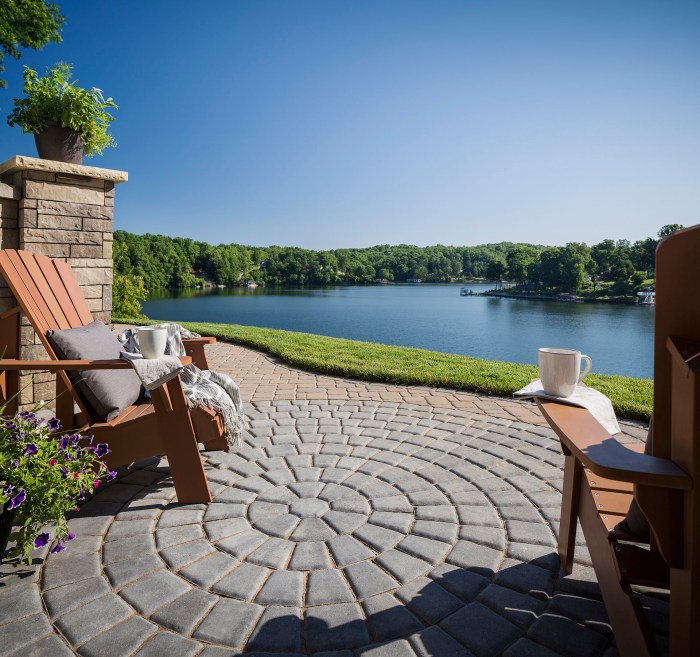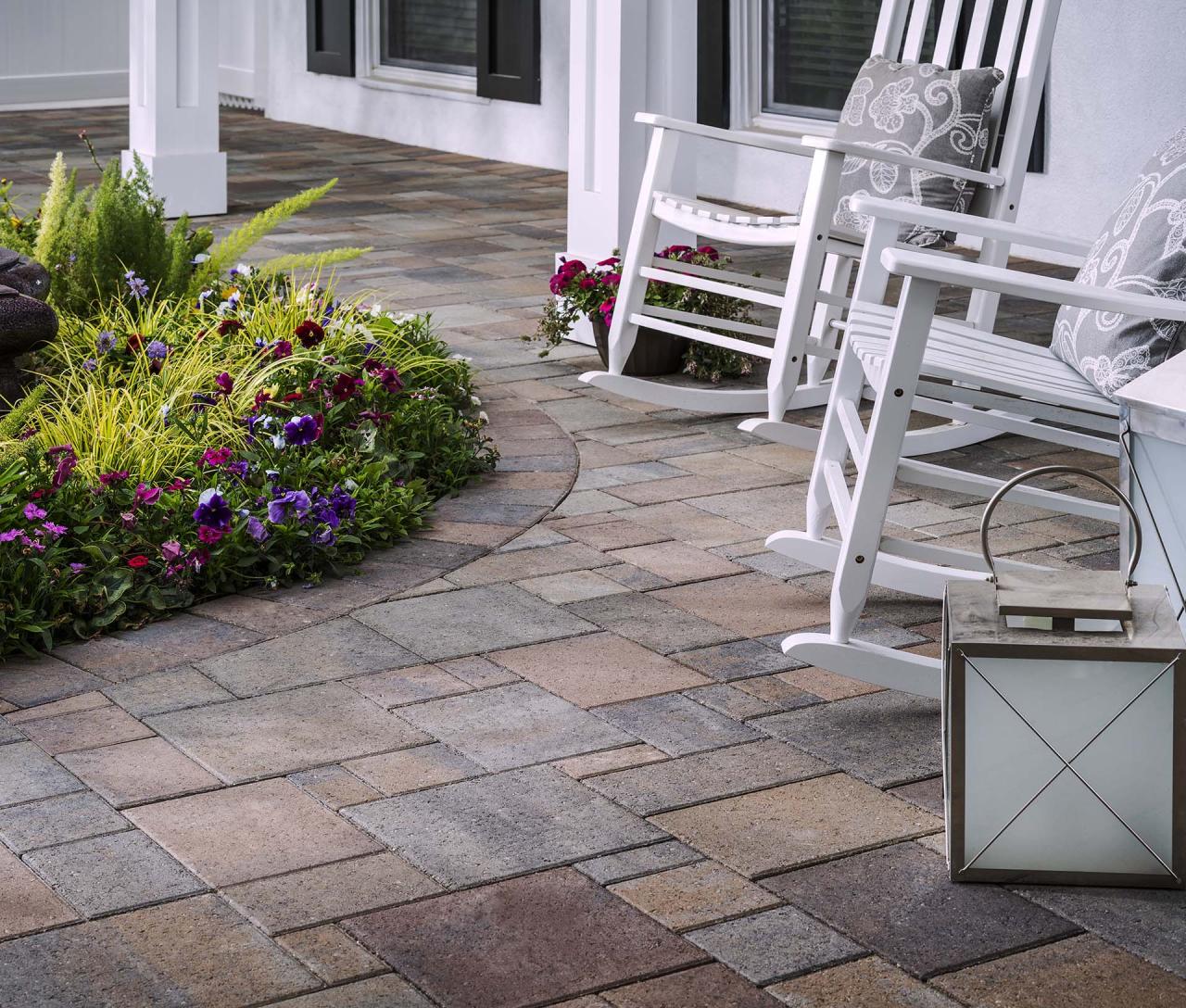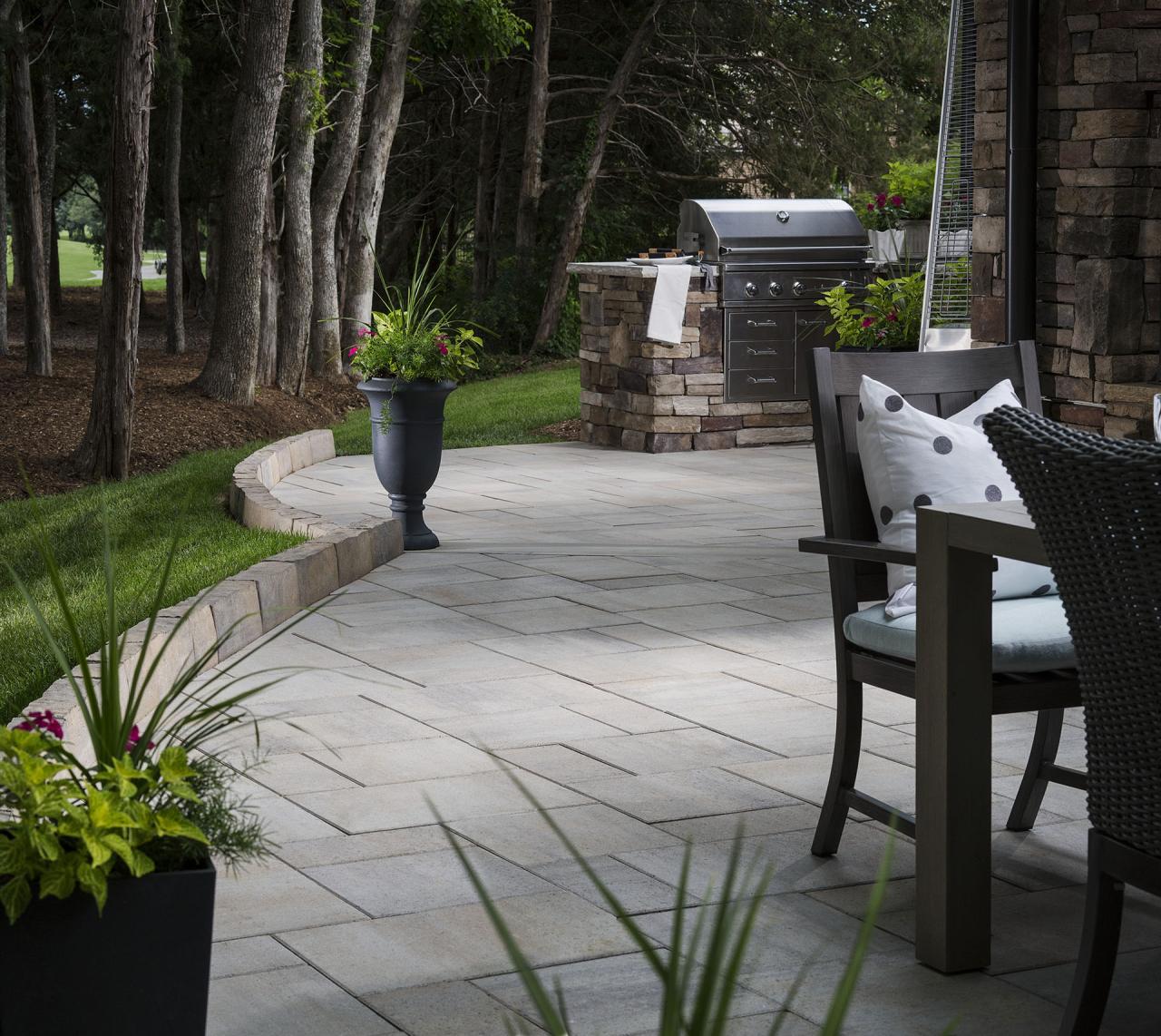Step into the realm of outdoor living with paver patios, where elegance and durability intertwine. These versatile outdoor spaces offer endless design possibilities, transforming your backyard into an oasis of comfort and style. From classic brick patterns to contemporary stone mosaics, paver patios are a testament to both functionality and aesthetic appeal.
In this comprehensive guide, we delve into the intricacies of paver patio design, materials, installation, maintenance, and cost, empowering you to create a stunning and enduring outdoor sanctuary.
Whether you envision a cozy seating area for intimate gatherings or a grand entertainment space for larger events, paver patios seamlessly adapt to your needs. With careful planning and execution, you can craft an outdoor masterpiece that complements your home’s architectural style and enhances your overall property value.
As we embark on this journey, let us explore the world of paver patios and discover the secrets to creating a timeless outdoor haven.
Paver Patio Design
Paver patios offer a versatile and durable outdoor living space. Designing a paver patio involves choosing the right materials, size, shape, and layout to complement your home and yard. Consider the following factors when planning your paver patio:
Size and Shape
The size and shape of your paver patio will depend on the available space and your intended use. Measure the area you have available and consider the size of your furniture and the number of people you typically entertain. Common paver patio shapes include rectangles, squares, circles, and free-form designs.
Materials
Pavers come in a variety of materials, including concrete, brick, natural stone, and porcelain. Each material has its own unique look, durability, and cost. Concrete pavers are a popular choice due to their affordability and durability. Brick pavers offer a classic look and are available in a variety of colors and textures.
Natural stone pavers, such as granite or limestone, provide a luxurious look and are highly durable. Porcelain pavers are a newer option that offers a wide range of colors and styles, and they are resistant to fading and staining.
Layout
The layout of your paver patio will depend on the size and shape of your space, as well as your personal preferences. Consider creating a focal point, such as a fire pit or water feature. You can also use pavers to create different zones, such as a dining area, a seating area, or a walkway.
Consider the flow of traffic when planning your layout.
Examples of Paver Patio Designs
Here are a few examples of paver patio designs to inspire you:
- A rectangular paver patio with a fire pit in the center creates a cozy and inviting space for entertaining.
- A circular paver patio with a water feature provides a tranquil and relaxing atmosphere.
- A free-form paver patio with a winding walkway leads to a secluded seating area, creating a sense of privacy and intimacy.
- A combination of different paver materials, such as concrete and brick, can create a unique and visually appealing design.
- A paver patio with a built-in seating wall provides additional seating and defines the space.
Paver Patio Materials
When selecting materials for your paver patio, it’s crucial to consider durability, cost, aesthetics, and maintenance requirements. Concrete, brick, and natural stone are the most popular options, each offering unique advantages and drawbacks.
Concrete Pavers
Concrete pavers are cost-effective and durable, making them a popular choice for patios. They come in a wide range of colors, shapes, and textures, allowing for customization. Concrete pavers are relatively easy to install and maintain, but they may crack or fade over time.
Brick Pavers
Brick pavers offer a classic and timeless look. They are highly durable and resistant to wear and tear. However, brick pavers can be more expensive than concrete pavers and require regular sealing to maintain their appearance.
Natural Stone Pavers
Natural stone pavers, such as granite, limestone, or slate, provide a luxurious and elegant touch to any patio. They are extremely durable and weather-resistant. However, natural stone pavers are typically more expensive and require professional installation.
Recent Trends and Innovations
The latest trends in paver patio materials include the use of large-format pavers, permeable pavers, and eco-friendly materials. Large-format pavers create a more seamless and modern look. Permeable pavers allow rainwater to infiltrate the ground, reducing runoff and improving drainage.
Eco-friendly materials, such as recycled glass or concrete, promote sustainability.
Paver Patio Installation
Installing a paver patio adds aesthetic appeal and functionality to your outdoor space. Follow these steps for a professional-looking installation:
Site Preparation
Clear the area of vegetation and remove the topsoil to a depth of 4-6 inches. Establish the desired slope for drainage, typically 1/4 inch per foot.
Base Layer
Compact the subgrade using a plate compactor. Spread a 2-inch layer of compacted gravel or crushed stone over the subgrade. Add a layer of paver base (crusher run) and compact it to a thickness of 1-2 inches.
Laying the Pavers
Start laying the pavers from the outside edge, working inward. Use a rubber mallet to tap the pavers into place, ensuring they are level. Check the height and alignment regularly.
Jointing Sand
Fill the joints between the pavers with polymeric sand. Use a broom to spread the sand evenly and compact it using a plate compactor.
Edging
Install edging around the perimeter of the patio to secure the pavers and prevent movement. Use paver restraints or metal edging.
Tips for Professional Installation
* Use a string line to ensure straight lines and even spacing.
- Cut pavers to fit around curves or obstacles using a wet saw or paver splitter.
- Allow for expansion joints by leaving 1/4-inch gaps between the pavers.
- Protect the patio from stains and damage by sealing it with a paver sealer.
Paver Patio Maintenance
Maintaining your paver patio is crucial for preserving its beauty, durability, and safety. Regular cleaning, sealing, and repairs will extend the lifespan of your patio and keep it looking its best.
Cleaning
Cleaning your paver patio regularly removes dirt, debris, and stains. Use a pressure washer with a low-pressure setting to avoid damaging the pavers. For stubborn stains, apply a mild cleaning solution of water and vinegar or a commercial paver cleaner.
Sealing
Sealing your paver patio protects it from stains, water damage, and the elements. Apply a high-quality paver sealant every two to three years. Choose a sealant that is specifically designed for the type of pavers you have.
Repairing
Repairing any cracks or damage to your paver patio is essential for maintaining its structural integrity and preventing further damage. For minor cracks, use a polymeric sand to fill them. For larger cracks or broken pavers, you may need to hire a professional to make the repairs.
Removing Stains
Stains on paver patios can be removed using various methods depending on the type of stain. For oil stains, use a degreaser. For rust stains, use a vinegar solution. For organic stains, such as mold or mildew, use a bleach solution.
Removing Weeds
Weeds can be a nuisance on paver patios. To remove them, use a weed killer that is safe for use on pavers. You can also manually remove weeds by pulling them out or using a hoe.
Paver Patio Cost
Installing a paver patio involves various cost factors, including materials, labor, and permits. Understanding these costs and finding ways to save money can help you create a beautiful and functional outdoor space within your budget.
The average cost of installing a paver patio ranges from $10 to $25 per square foot. However, this cost can vary depending on the size of the patio, the type of pavers used, the complexity of the design, and the local labor rates.
Materials
The cost of pavers varies depending on the material, size, and style. Concrete pavers are the most affordable option, ranging from $2 to $5 per square foot. Brick pavers are more expensive, ranging from $5 to $10 per square foot.
Natural stone pavers, such as granite or limestone, are the most expensive, ranging from $10 to $20 per square foot.
Labor
The cost of labor for installing a paver patio typically ranges from $5 to $10 per square foot. This cost includes preparing the base, laying the pavers, and sealing the patio. The complexity of the design and the size of the patio can affect the labor costs.
Permits
In some areas, you may need to obtain a permit to install a paver patio. The cost of a permit varies depending on the size of the patio and the local building codes. It’s important to check with your local building department to determine if a permit is required.
Ways to Save Money
- Choose affordable pavers. Concrete pavers are the most affordable option, and they come in a variety of colors and styles.
- Install the pavers yourself. If you’re handy, you can save money by installing the pavers yourself. However, it’s important to do your research and make sure you have the proper tools and knowledge.
- Get multiple quotes from contractors. Before hiring a contractor, get multiple quotes to compare prices. This will help you find the best value for your money.
Tips for Finding Reputable Contractors
- Ask for referrals from friends or family members who have had paver patios installed.
- Check online reviews of contractors in your area.
- Make sure the contractor is licensed and insured.
- Get a written contract that Artikels the scope of work, the cost, and the payment schedule.
Final Conclusion
As we conclude our exploration of paver patios, it is evident that these outdoor havens are more than just functional spaces; they are extensions of our living areas, inviting us to connect with nature and create lasting memories. With careful consideration of design, materials, installation, and maintenance, you can transform your backyard into a stunning oasis that will endure for years to come.
Whether you opt for classic elegance or modern flair, a paver patio is a wise investment that will elevate your outdoor living experience and bring joy to your life. As you embark on this exciting journey, remember that the possibilities are endless, and with a touch of creativity and passion, you can create a paver patio that truly reflects your unique style and enhances the beauty of your home.



